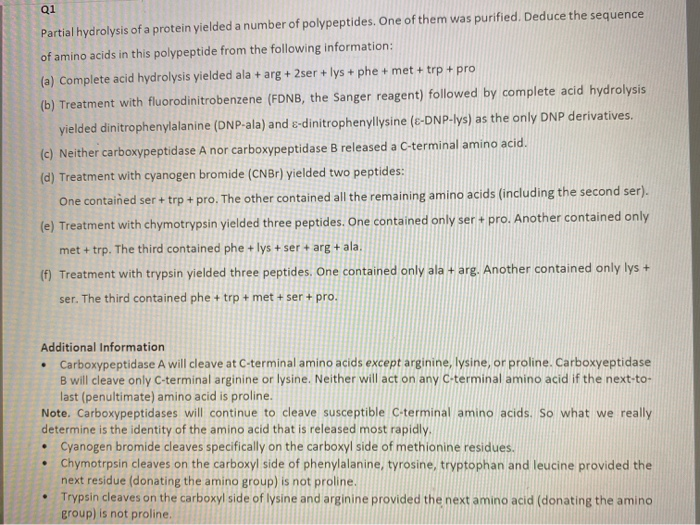Partial hydrolysis of a protein yielded a number of polypeptides. One of them was purified. Deduce the sequence of amino acids in this polypeptide from the following information: (a) Complete acid hydrolysis yielded ala + arg + 2ser + lys + phe + met + trp + pro (b) Treatment with fluorodinitrobenzene (FDNB, the Sanger reagent) followed by complete acid hydrolysis yielded dinitrophenylalanine (DNP-ala) and a dinitrophenyllysine (e-DNP-lys) as the only DNP derivatives. (c) Neither carboxypeptidase A nor carboxypeptidase B released a C-terminal amino acid. (d) Treatment with cyanogen bromide (CNBr) yielded two peptides: One contained ser + trp + pro. The other contained all the remaining amino acids (including the second ser). (e) Treatment with chymotrypsin yielded three peptides. One contained only ser + pro. Another contained only met + trp. The third contained phe + lys + ser + arg + ala. (f) Treatment with trypsin yielded three peptides. One contained only ala + arg. Another contained only lys + ser. The third contained phe + trp + met + ser + pro
Partial hydrolysis of a protein yielded a number of polypeptides. One of them was purified. Deduce the sequence of amino acids in this polypeptide from the following information:
(a) Complete acid hydrolysis yielded ala + arg + 2ser + lys + phe + met + trp + pro
(b) Treatment with fluorodinitrobenzene (FDNB, the Sanger reagent) followed by complete acid hydrolysis yielded dinitrophenylalanine (DNP-ala) and a dinitrophenyllysine (e-DNP-lys) as the only DNP derivatives.
(c) Neither carboxypeptidase A nor carboxypeptidase B released a C-terminal amino acid.
(d) Treatment with cyanogen bromide (CNBr) yielded two peptides: One contained ser + trp + pro. The other contained all the remaining amino acids (including the second ser).
(e) Treatment with chymotrypsin yielded three peptides. One contained only ser + pro. Another contained only met + trp. The third contained phe + lys + ser + arg + ala.
(f) Treatment with trypsin yielded three peptides. One contained only ala + arg. Another contained only lys + ser. The third contained phe + trp + met + ser + pro

Trending now
This is a popular solution!
Step by step
Solved in 2 steps









